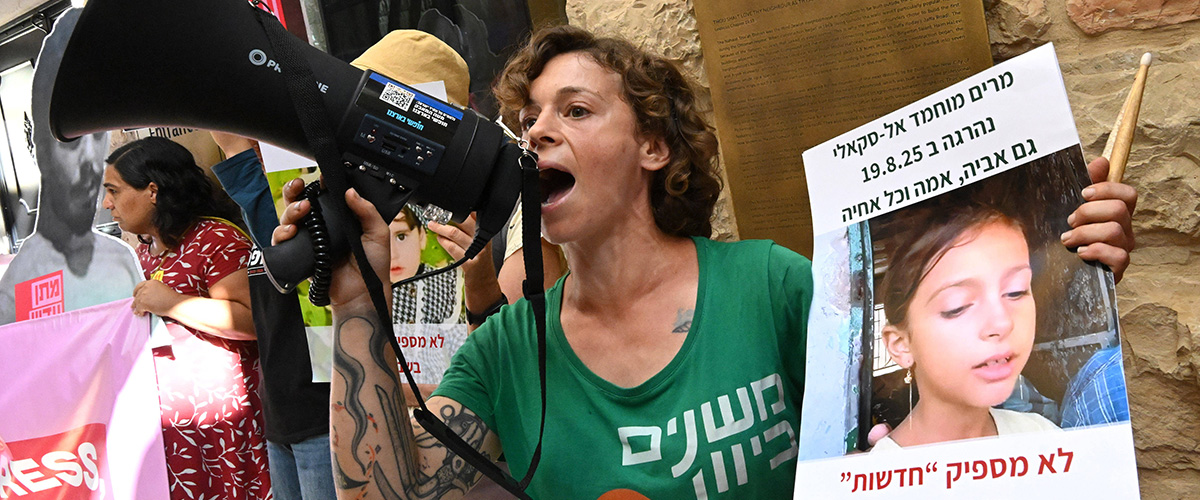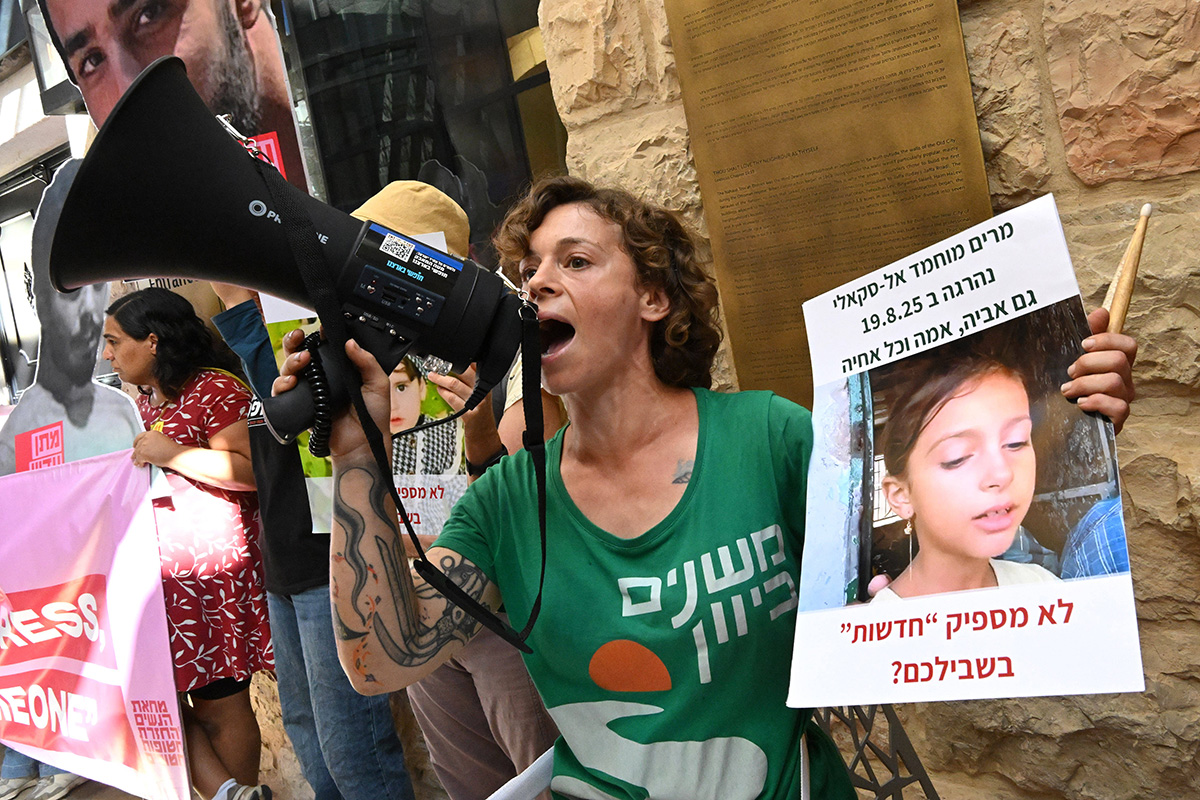Famine in Gaza – a ceasefire and hostage deal are the order of the day

For almost two years now, since October 7, 2023, the day on which the terrorist organization Hamas attacked Israel, brutally murdering 1,200 civilians and taking 240 hostages, war has been raging in Gaza. A war that is being waged with unabated ferocity – on both sides. Kerstin Müller, Program Director for the Middle East Network, analyzes the current situation.
The Netanyahu government’s declared war aim is the destruction of Hamas. For almost two years, however, the Israeli military has failed to force Hamas to surrender, let alone destroy it. What is traumatic and far more significant for Israeli society, however, is that the other declared goal – the liberation of the hostages still being held – has failed due to the military action taken so far: 53 people remain in the hands of Hamas, where they are being tortured and starved to death in underground tunnels, or have already been murdered. It is likely that barely more than 20 of them are still alive.
The few hostages who have since been released were freed in exchange for hundreds of Palestinian prisoners during the only ceasefire from January 19 to March 2, 2025. Netanyahu’s extremist government, however, is now relying exclusively on military action – diplomatic options are no longer on the agenda. The majority of the cabinet even rejected a renewed partial deal and decided on August 20 to take Gaza by military force instead. Ergo: the war will continue with even greater intensity. It is not only the international community that is up in arms about this escalation. Hundreds of thousands of Israelis are also taking to the streets every day to demonstrate alongside the families of the hostages for an immediate end to the war and a ceasefire.
“Bring them home!”
... is the demand of the demonstrators – they are shouting it in the streets and squares of Tel Aviv. But Netanyahu and his extremist ministers Smotrich and Ben Gvir are deaf to these cries from their own people. No wonder: they are pursuing a different plan – and quite openly so. Finance Minister Smotrich calls for “the Gaza Strip to be taken, occupied and settled.” To achieve this goal, “no humanitarian aid should be allowed in.” Security Minister Ben Gvir, chairman of the radical Otzma Yehudit party, which serves as Netanyahu’s majority provider, has stated that he hopes that the Palestinians in Gaza will eventually suffer so much that they will want to leave the area “voluntarily.” During the infamous flag march by right-wing settlers in Jerusalem in May, he demanded: “We must not give them humanitarian aid, we must not give them fuel (...) Our enemies deserve a bullet in the head!” With statements like these, he is not only providing the International Criminal Court with ammunition. Anti-Semites around the world have also been waiting for an opportunity to speak of genocide in Gaza and thus pillory Israel internationally. To do so, “genocidal intent” is required under criminal law, but so far this has not been proven against the government. Its stated goal has been to destroy the terrorist organization Hamas so that something like what happened on October 7, 2023, can “never happen again.” It is morally and legally justified in doing so. However, enforcing this is proving more difficult than expected. Ben Gvir’s statement is now sowing doubt worldwide, even among Israel’s few remaining friends: Is Netanyahu’s government really primarily concerned with destroying Hamas, or does it rather intend to expel the Palestinians from Gaza?
IPC report: Famine in Gaza
These doubts have now been given new fuel: the latest IPC report, the so-called Integrated Food Security Phase Classification, has declared Gaza to be in a state of level 5 famine. The report takes into account all data from international organizations such as the FAO, WHO, USAID, UNICEF, the World Food Program, and the German GIZ. In order to classify a situation as famine, three very strict criteria must be met:
1. extreme food insecurity affecting at least 20% of households,
2. acute malnutrition affecting more than 30% of children, and
3. a significant mortality rate caused by hunger or malnutrition.
The report states: “After 22 months of relentless conflict, over half a million people in the Gaza Strip are facing catastrophic conditions characterized by hunger, misery, and death.” It therefore makes an alarming demand: “As this famine is entirely man-made, it can be stopped and reversed. The time for debate and hesitation is over; hunger is already present and spreading rapidly. No one should doubt that an immediate and large-scale response is required.”
Rarely has there been such a harrowing document, and rarely have international organizations made such a unanimous and alarming attempt to shake the international community awake. The Israeli government still denies that there is a famine in Gaza, but its arguments are unconvincing. Even the “foundation” hastily set up by the government a few months ago, the GHF (Gaza Humanitarian Foundation), with its four distribution centers and barely more than 25 truckloads per day, is nowhere near capable of adequately supplying the 2.2 million people in Gaza – not to mention that it does not adhere to basic principles of humanitarian aid such as neutrality, impartiality, and independence. At least 500–600 trucks per day would be needed to ensure supplies.
It is therefore high time to finally take action. How should the international community respond? And how should the German government respond—after all, Israel’s security is Germany’s declared raison d’état? Are sanctions, or even a boycott and arms embargo against Israel, or the international proclamation of a Palestinian state—as called for by the UN initiative of Macron and Saudi Arabia—the right response to a famine in Gaza? If the UN does indeed recognize a Palestinian state by resolution in September, this would perhaps be an important step for the Palestinians – but in the end, it would only be symbolic politics. The current Israeli government will hardly care; rather, it will exploit such demands domestically against the opposition. For the people on the ground, however, nothing will really change until both sides to the conflict agree on a two-state solution – in other words, after a process of negotiation.
A future for Israelis and Palestinians only without Hamas
Based on past experience with such demands, it is doubtful that they will be successful. Instead, the focus of all considerations must be on what will actually help the people in Gaza and what measures will bring the Israeli hostages back to Israel from Gaza. It should not be a matter of pandering to voters “at home”: If, for example, one calls for an arms embargo, as German Chancellor Merz recently announced for Gaza, one also needs a clear answer as to how Hamas can then be disarmed and defeated.
After all, Hamas is also responsible for the hunger of its own population: according to Hamas, the Palestinians in Gaza are currently dying an honorable “martyr’s death.” More than 80 percent of trucks carrying humanitarian aid for the population of the Gaza Strip are looted by Hamas or other marauding gangs. These are the official figures from the United Nations. If more aid is allowed into Gaza – which is urgently needed – a protection concept for these deliveries is also needed to ensure that the aid actually reaches the people and is not hijacked by Hamas. Once again, the United Nations must not shy away from this debate.
Furthermore, it is completely unrealistic and unfeasible to build a “democratic and demilitarized Palestinian state” with Hamas, as demanded by all UN resolutions: Hamas will fight such a prospect of a two-state solution with terror until the very end. The Hamas leaders have just made this clear once again from exile.
Truth is the first casualty of war
What exactly is happening in the Gaza war? We will only be able to answer this question fully in retrospect, after the war has ended – if at all. One thing is clear: no peaceful state can be built on the ruins of a completely destroyed Gaza Strip and on the backs of half a million starving children and adults, as well as thousands of dead and injured. And the hostages can only be “brought home” – as Israeli demonstrators are demanding – if there is first a ceasefire and a hostage deal as soon as possible. But that also means that Hamas’s terror must continue to be fought – albeit with other means. At the same time, however, the people in Gaza must now be provided with the necessities of life, the Israeli hostages must be freed through a hostage deal, and Gaza and the West Bank must finally be given a political perspective.
The latter, however, lies primarily in the hands of the Israeli and Palestinian people – ultimately, they must finally elect governments that have an interest in peace between the peoples of the Middle East.
Hat Ihnen unser Beitrag gefallen? Dann spenden Sie doch einfach und bequem über unser Spendentool. Sie unterstützen damit die publizistische Arbeit von LibMod.
Wir sind als gemeinnützig anerkannt, entsprechend sind Spenden steuerlich absetzbar. Für eine Spendenbescheinigung (nötig bei einem Betrag über 200 EUR), senden Sie Ihre Adressdaten bitte an finanzen@libmod.de
Verwandte Themen
Newsletter bestellen
Mit dem LibMod-Newsletter erhalten Sie regelmäßig Neuigkeiten zu unseren Themen in Ihr Postfach.




